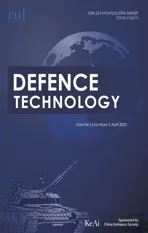Influence of high overload on the collimating lenses of laser ranging systems
2020-05-23LinGnHeZhngBinLiuJunhongWng
Lin Gn , He Zhng , Bin Liu , Junhong Wng
a Nanjing University of Science and Technology, School of Mechanical Engineering, Nanjing 210094, China
b Northwest Industrial Group Co., Ltd., Xi’an, China
Keywords:High overload Laser ranging Emission lens Buffer isolation
ABSTRACT Collimating lenses are an important component of laser ranging systems, and high overload environments severely affect the beam shaping effect of such lenses. This study proposes a buffer isolation method on the basis of impact stress wave attenuation theory for collimating lens spacers. ANSYS finite element software was applied to simulate the high load dynamics of collimating lenses, and the buffer isolation performance of different materials and composite structures was compared and analysed.Optical simulation analysis of the collimating lenses under different buffer conditions was performed using ZEMAX software to study the mechanism by which a high overload affects the collimating lenses.High overload and optical shaping experiments based on theoretical analysis were further conducted.Results showed the superiority of butadiene rubber to polytetrafluoroethylene after application of 70000 g impact acceleration.The combination-gasket method was superior to the single-gasket method,and the sandwich combination-gasket method was superior to the double-layer combination-gasket method.
1. Introduction
Laser ranging is used extensively in the civil, aerospace and military fields [1-4]. In the military field, laser ranging systems must typically withstand large launch overloads(≤70000 g)[5-7].Given the precision of laser collimating lenses and the specific properties of the material from which they are made, these lenses are plastically deformed when subjected to a high overload,thereby diminishing the accuracy of distance measurements [8,9].
Generally, the effect of high overload on laser ranging systems can be reduced in two ways, namely, (1) optimising the laser ranging structure and (2) designing a suitable vibration isolation system [10]. For pathway 1, the literature [11,12] has studied the impact responses of high overload structures and found that despite certain benefits exerted by such approaches, they are considerably restricted by the adopted structure. By comparison,pathway 2 is a more effective technical approach because it can reduce impact loads by implementing a vibration isolation system without changing the structure of the laser system[13,14].
This study proposes a gasket buffer vibration isolation method on the basis of impact stress wave propagation theory. The nonlinear dynamics of a high load was simulated using ANSYS finite element analysis software,and the stresses of the laser collimating lens under different buffer conditions were compared and analysed. ZEMAX software was used to simulate the laser collimating lens optically to determine the changes in beam shaping quality.High overload impact tests and optical shaping experiments were conducted to record impact acceleration curves and beam shaping quality under different buffer conditions.Finally,the actual effect of the buffer vibration isolation method was verified.
2. Impact stress wave propagation theory
The transmitting overload was simplified as a half-sinusoidal acceleration load, as shown in Fig.1.
The expression is
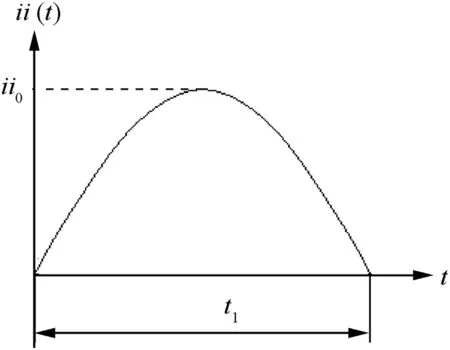
Fig.1. Half-sinusoidal acceleration load.

In view of space constraints,spring isolation systems cannot be used to improve the resistance of a high overload system[15,16].In this study,a gasket was used to attenuate the impact gravitational wave [17-19]. During the impact process, the velocity of elastic wave propagation in a material under uniaxial strain is

whereC0is the wave velocity, and ρ0C0is the material wave impedance.
During stress wave propagation, the intensity relationship among the reflected,transmitted and incident waves is as follows:

where the stress wave reflection coefficientFis expressed as

The transmission coefficientTis expressed as

The wave impedance rationof different materials is

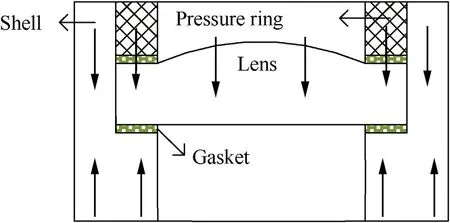
Fig. 2. Schematic of the spread of stress waves in a laser emission system.
σRmeans“Stress generated by particle vibration of reflected wave”,νRmeans “The velocity of the particle vibration of the reflected wave”, σTmeans “Stress generated by particle vibration of transmitted wave”,νTmeans“The velocity of the particle vibration of the transmitted wave”.
The propagation process of stress waves inside a laser emission system is shown in Fig. 2.
During the high overload process, the stress wave propagates from the bottom to the top of the system.When a wave encounters the interface of different materials, it is reflected and transmitted.The transmission portion of the wave propagates towards the interior of the system. When the transmission stress wave propagates to the junction of the gasket, the wave impedances of the gasket and shell materials are considerably varied. The transmission coefficient is significantly smaller than that of the outer body,and part of the stress wave is reflected to form a tensile wave and other transmission portions. The stress wave is reflected and transmitted multiple times at the gasket, thereby resulting in attenuation.
As a gasket material, polytetrafluoroethylene (PTFE) exhibits strong corrosion and weather resistance; it is non-hygroscopic,non-flammable, chemically stable and can be used in the temperature range of 190°C-260°C. Thus, such features provide stable mechanical properties. Rubber has extremely high elasticity and tensile strength, which can effectively absorb impact energies and mitigate impact to reduce impact deformation. In this work, the buffer isolation effects of these materials were compared and analysed. Table 1 lists the parameters of the two materials.
3. Nonlinear dynamics simulation
Eight-node 3D Solid164 solid elements were selected for modelling.In view of structural symmetry,a 1/4 model was created to simplify the operations and ensure the accuracy of the results.
The strain rate effect and failure were investigated when the laser ranging system was subjected to a strong impact acceleration.Simulation was performed using the *MAT_PLASTIC_KINEMATIC elastic-plastic dynamic model by adjusting β to select isotropichardening parameters or servo stiffness. The strain rate was obtained by the Cowper-Symonds model. The yield stress was calculated as

Table 1 Housing and cushioning material parameters.

Fig.3. Maximum stress cloud on the front side of the emission lens:(a)1 mm PTFE cushioning material,(b)1 mm butadiene rubber cushioning material,(c)0.5 mm PTFE+0.5 mm butadiene rubber and (d) 0.3 mm butadiene rubber + 0.4 mm PTFE + 0.3 mm butadiene rubber.
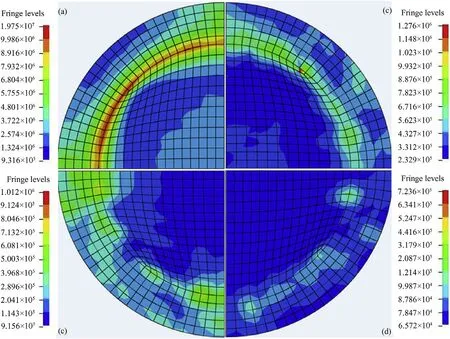
Fig.4. Maximum stress cloud on the back side of the emission lens:(a)1 mm PTFE cushioning material,(b)1 mm butadiene rubber cushioning material,(c)0.5 mm PTFE+0.5 mm butadiene rubber and (d) 0.3 mm butadiene rubber + 0.4 mm PTFE + 0.3 mm butadiene rubber.

where σ0is the initial yield stress, ε˙ is the strain rate,CandPCowper-Symonds are the strain rate parameters,is the effective plastic strain andEPis the plastic hardening modulus.
A 70000 g half-sinusoidal impact acceleration was applied to the laser ranging system for a duration of 12 ms. The CONTACT_ERODING_SURFACE_TO_SURFACE algorithm was selected at the contact.
Fig.3(a)and Fig.4(a)show the maximum stress cloud of a laseremitting lens with a 1 mm PTFE buffer.The maximum stress of the lens (19.75 MPa) appears at 10524 nodes, and Fig. 5(a) shows the related stress curve. Figs. 3(b) and 4(b) depict the stress cloud diagram of 1 mm butadiene rubber as the cushioning gasket. The maximum stress(1.276 MPa)appears at 10336 nodes,and Fig.5(b)shows the related stress curve.The results of this simulation show that butadiene rubber is superior to PTFE in terms of buffering performance.
The buffering efficiency of the combination-gasket method is analysed. Firstly, a double-layer combination of 0.5 mm PTFE and butadiene rubber was implemented, and Figs. 3(c) and 4(c) show the related stress cloud diagrams.The maximum stress(1.012 MPa)appears at 10383 nodes, and Fig. 5(c) shows the related stress curve. The combination of the two gaskets further attenuates the stress wave at the interface of the different materials. As such, the maximum stress in the system is less than that observed after buffering with the monomer material, the impact curve jitter is reduced and the smoothness is improved.
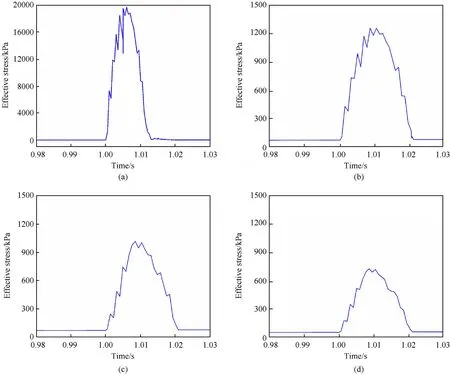
Fig.5. Maximum stress curves:(a)1 mm PTFE cushioning material,(b)1 mm butadiene rubber cushioning material,(c)0.5 mm PTFE+0.5 mm butadiene rubber and(d)0.3 mm butadiene rubber + 0.4 mm PTFE + 0.3 mm butadiene rubber.
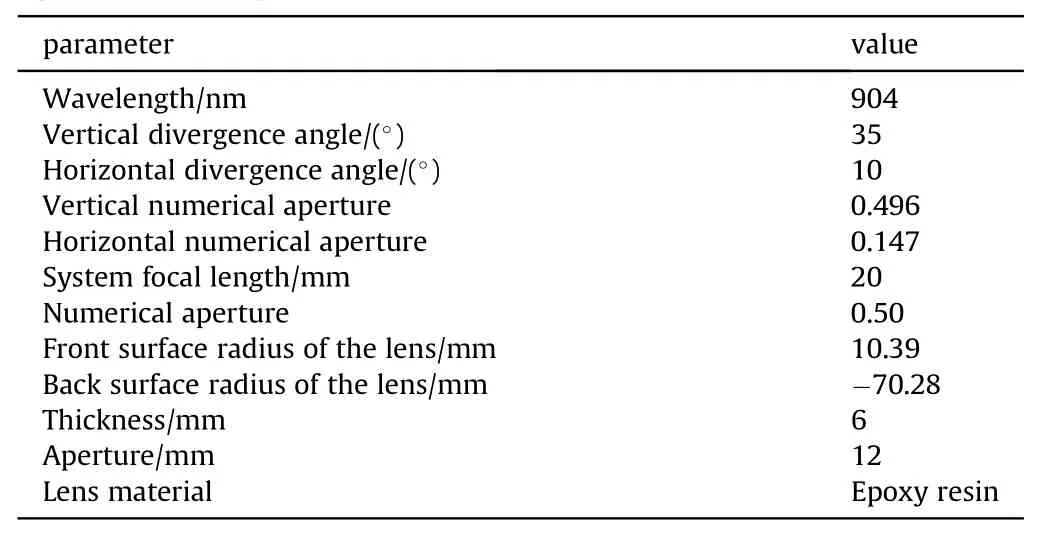
Table 2 Optical simulation parameters.
The buffering effect of the sandwich combination-gasket method was then investigated using a three-layer combination of butadiene rubber-PTFE-butadiene rubber. Figs. 3(d) and 4(d)show the related stress cloud diagrams. The maximum stress(0.7236 MPa)appears at 10426 nodes,and Fig.5(d)shows the stress curve in comparison with the two-layer buffer gasket,this method includes a third layer, and the stress wave is further attenuated inside the gasket. Therefore, the sandwich combination-gasket method displays the smallest impact stress peak and the smoothest curve among the gasket configurations tested.
4. Emission lens optical simulation
This study utilises a pulse semiconductor laser, and ZEMAX optical system analysis software is applied to simulate the collimation effect. Table 2 lists the relevant parameters.
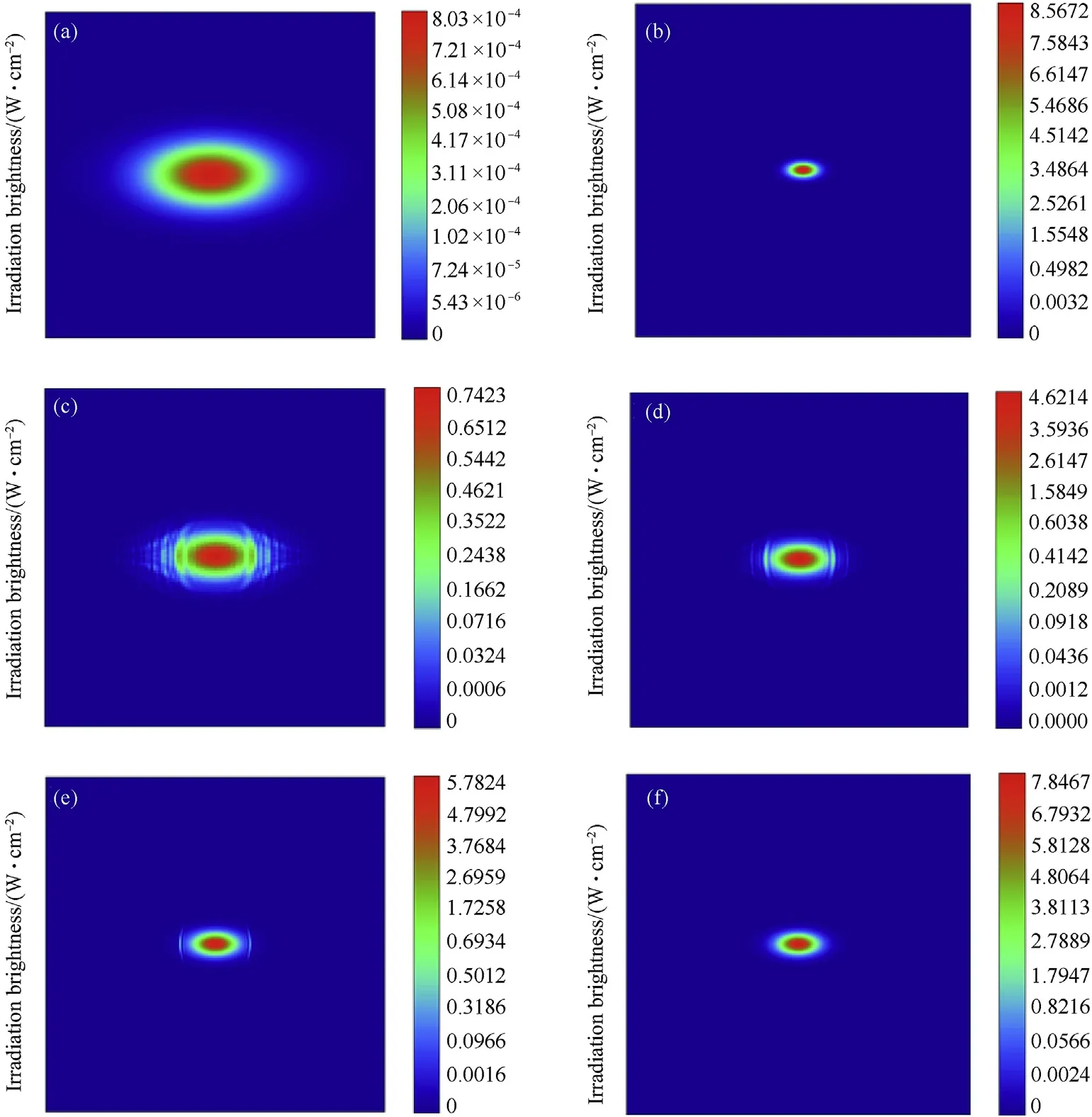
Fig. 6. Far-field spot samples: (a) Original spot,(b) spot after collimation, (c) collimation spot after impact with 1 mm PTFE, (d) collimation spot after impact with mm butadiene rubber, (e) collimation spot after impact with 0.5 mm PTFE and 0.5 mm butadiene rubber and (f) collimation spot after impact with 0.3 mm butadiene rubber + 0.4 mm PTFE + 0.3 mm butadiene rubber.
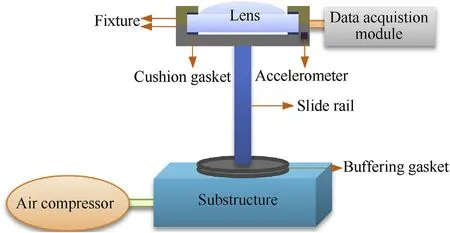
Fig. 7. Principle and structure of the impact test.
Fig. 6(a) shows the original spot. The spot energy is diverged,and the central irradiation brightness is 8.03×10-4W/cm2.Fig. 6(b) shows the spot obtained after the collimation of the lens.The energy of the spot is concentrated, and the central radiation brightness reaches 8.5672 W/cm2. After the application of a high overload, the collimated spot energy observed after buffering by the PTFE gasket is diverged, the spot is not uniform (Fig. 6(c)) and the central irradiation brightness is reduced to 0.7423 W/cm2. As shown in Fig.6(d),the spot energy of the butadiene rubber buffer is concentrated,the spot is uneven,the size is reduced and the central irradiation brightness is increased to 4.6214 W/cm2. As shown in Fig. 6(e), the size of the spot after buffering by the double-layer combination gasket continues to decrease, the energy is concentrated and the central irradiation brightness reaches 5.7824 W/cm2. The sandwich combination gasket exhibits the smallest uniform spot (Fig. 6(f)), which is consistent with the quality of the focused spot before impact, a concentrated energy and a central irradiation brightness of 7.8467 W/cm2. Comparison shows that the quality of the laser collimating lens spot significantly varies under different buffer conditions after the application of a 70000 g acceleration overload.Butadiene rubber is superior to Teflon,and the sandwich combination-gasket method is superior to the double-layer combination-gasket method.
5. High overload and optical shaping experiments
To verify the influence of high overload on laser emission systems, impact tests were conducted in the laboratory. Fig. 7 shows the principle of the impact test.An air pump generates pressure to drive the impact table to generate acceleration.The impact load is acquired by the acceleration detection module,and the lens is fixed at the top of the impact table. Shock was applied to 1 mm PTFE,1 mm butadiene rubber, 0.5 mm PTFE +0.5 mm butadiene rubber and 0.5 mm butadiene rubber +0.5 mm PTFE +0.5 mm butadiene rubber.Acceleration was set to 70000 g,and the impact was applied thrice under each condition.The impact parameters under different conditions were then recorded.Fig.8(a)~8(d)show the data curves.The largest stress peak (approximately 1200 kPa) is detected after buffering with 1 mm butadiene rubber, whereas the lowest stress peak (approximately 700 kPa) is observed from the ‘sandwich’gasket of 0.5 mm butadiene rubber + 0.5 mm PTFE + 0.5 mm butadiene rubber. The three methods show insignificant differences in pulse width, all of which are approximately thrice the original impulse pulse width. This finding is consistent with the simulation results.
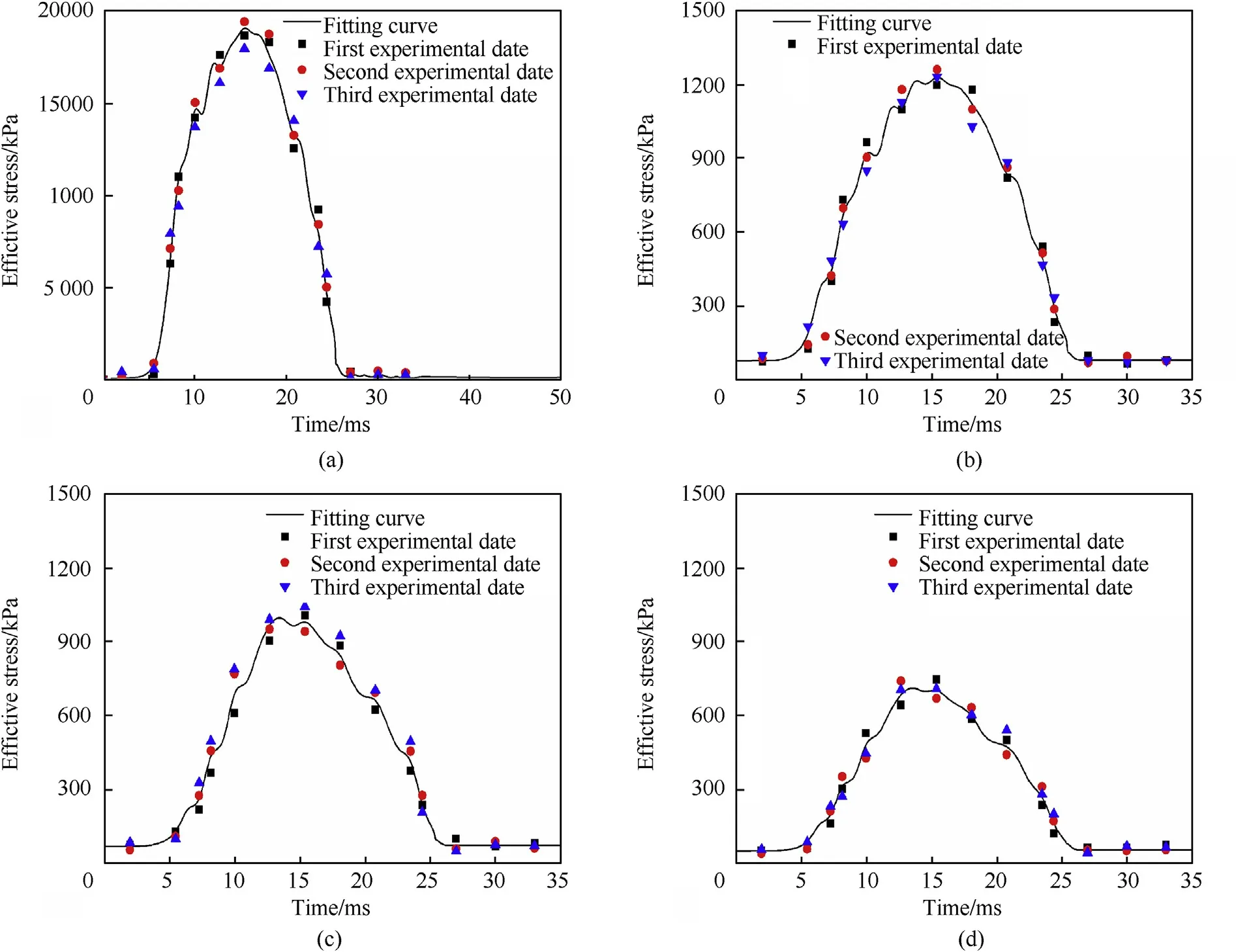
Fig.8. Acceleration curves:(a)1 mm PTFE,(b)1 mm butadiene rubber,(c)0.5 mm PTFE and 0.5 mm butadiene rubber and(d)0.3 mm butadiene rubber+0.4 mm PTFE+0.3 mm butadiene rubber.
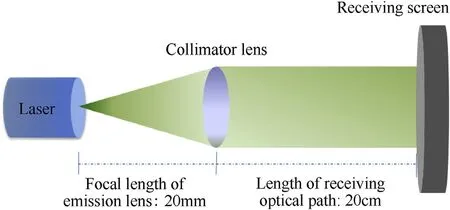
Fig. 9. Spotting experimental principle.
A spotting experiment was performed on the emission lens.Fig.9 presents the experimental principle,and Fig.10(a)~10(f)show the measured spots. The original speckle size is extremely large,and the energy dissipates. After shaping by the lens, the speckle energy is concentrated and the spot size decreases. After the application of a high overload, the spot energy obtained after buffering by the PTFE gasket is diverged, whereas that observed after buffering by the butadiene rubber gasket is concentrated and its size is reduced. The size of the spot observed after buffering by the double-layer gasket continues to decrease, and the energy is concentrated. Buffering by the sandwich combination pad yields the smallest uniform spot size and concentrated energy, which is consistent with the quality of the shaped spot before impact.Comparison indicates that the spot quality significantly varies under different buffer conditions after applying a 70,000gacceleration overload. The laser energy and spot size in the sandwich combination-gasket mode are virtually identical to those observed before impact.
6. Conclusion
To investigate the influence of a high overload environment on laser emission systems, this study proposes a buffer isolation method on the basis of stress wave propagation theory. Dynamic and optical simulations and experimental methods were used to compare and analyse the damping performance of different vibration isolation materials and combinations.The results show that butadiene rubber exerts excellent vibration isolation effects, and the overload observed after buffering with this material is only 1/15 that of PTFE.In addition,the beam shaping quality of the former is approximately seven times higher than that of the latter. The double-layer or sandwich combination of PTFE and rubber can further improve the buffering effects,and the buffer peak overload of the sandwich combination mode is 1/27 that of PTFE and 1/14 that of the double layer.The quality of spot shaping after buffering by the sandwich combination is consistent with the quality of spot shaping before impact.The proposed method simplifies the system structure, reduces the influence of high overload on the laser emission system and improves the working stability of the system.
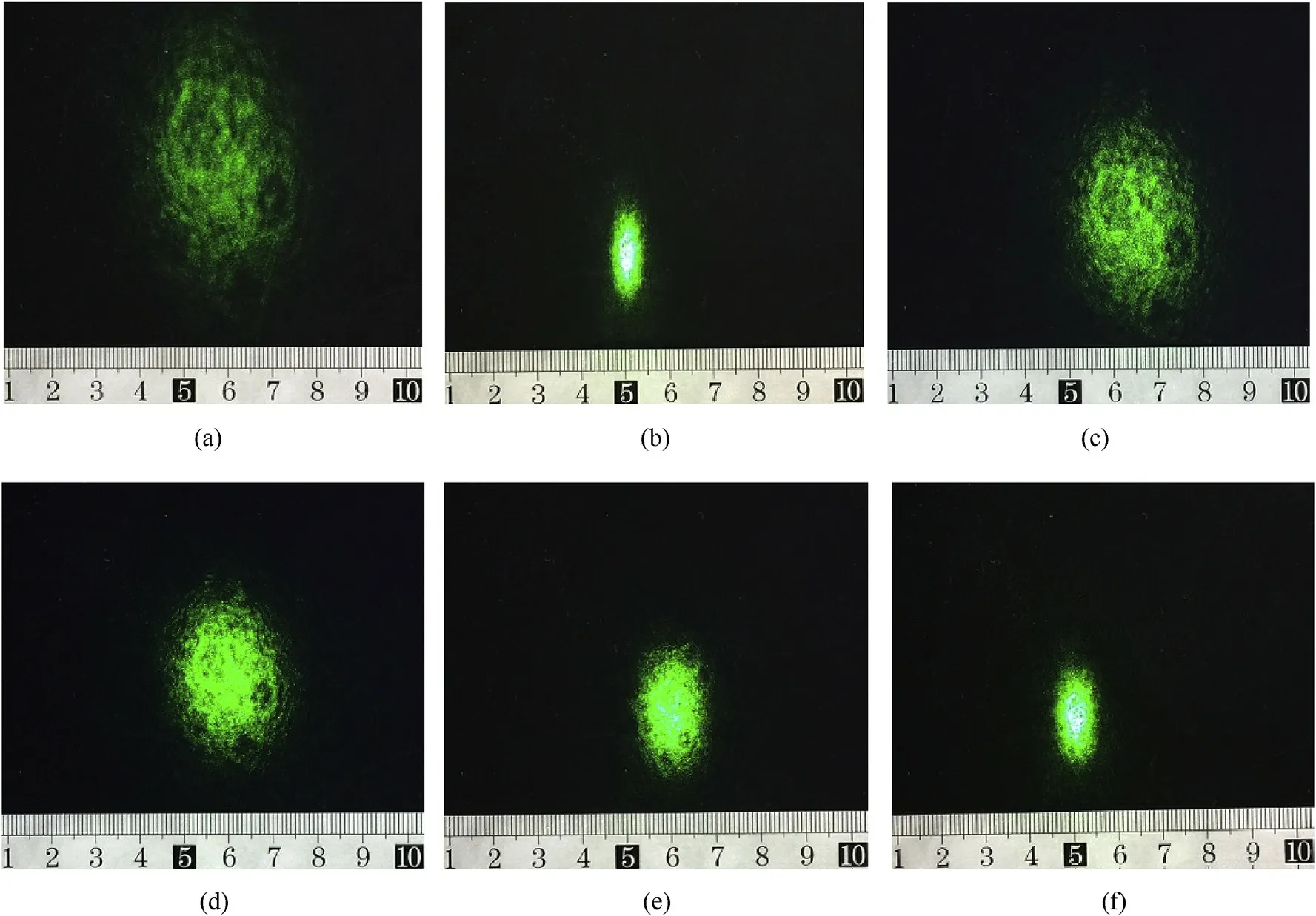
Fig.10. Experimental far-field spot samples: (a) Original spot, (b) spot after collimation, (c) collimation spot after impact with 1 mm PTFE, (d) collimation spot after impact with 1 mm butadiene rubber, (e) collimation spot after impact with 0.5 mm PTFE and 0.5 mm butadiene rubber and (f) collimation spot after impact with 0.3 mm butadiene rubber + 0.4 mm PTFE + 0.3 mm butadiene rubber.
Funding
National Natural Science Foundation of China (51605227); the Fundamental Research Funds for the Central Universities(NUST30915011303).
杂志排行
Defence Technology的其它文章
- A comparison of the ballistic behaviour of conventionally sintered and additively manufactured alumina
- Effect of operating temperature on aged single lap bonded joints
- Investigation on energy output structure of explosives near-ground explosion
- Characteristics structure analysis on debris cloud in the hypervelocity impact of disk projectile on thin plate
- A fast-running method for blast load prediction shielding by a protective barrier
- Coating processes towards selective laser sintering of energetic material composites
